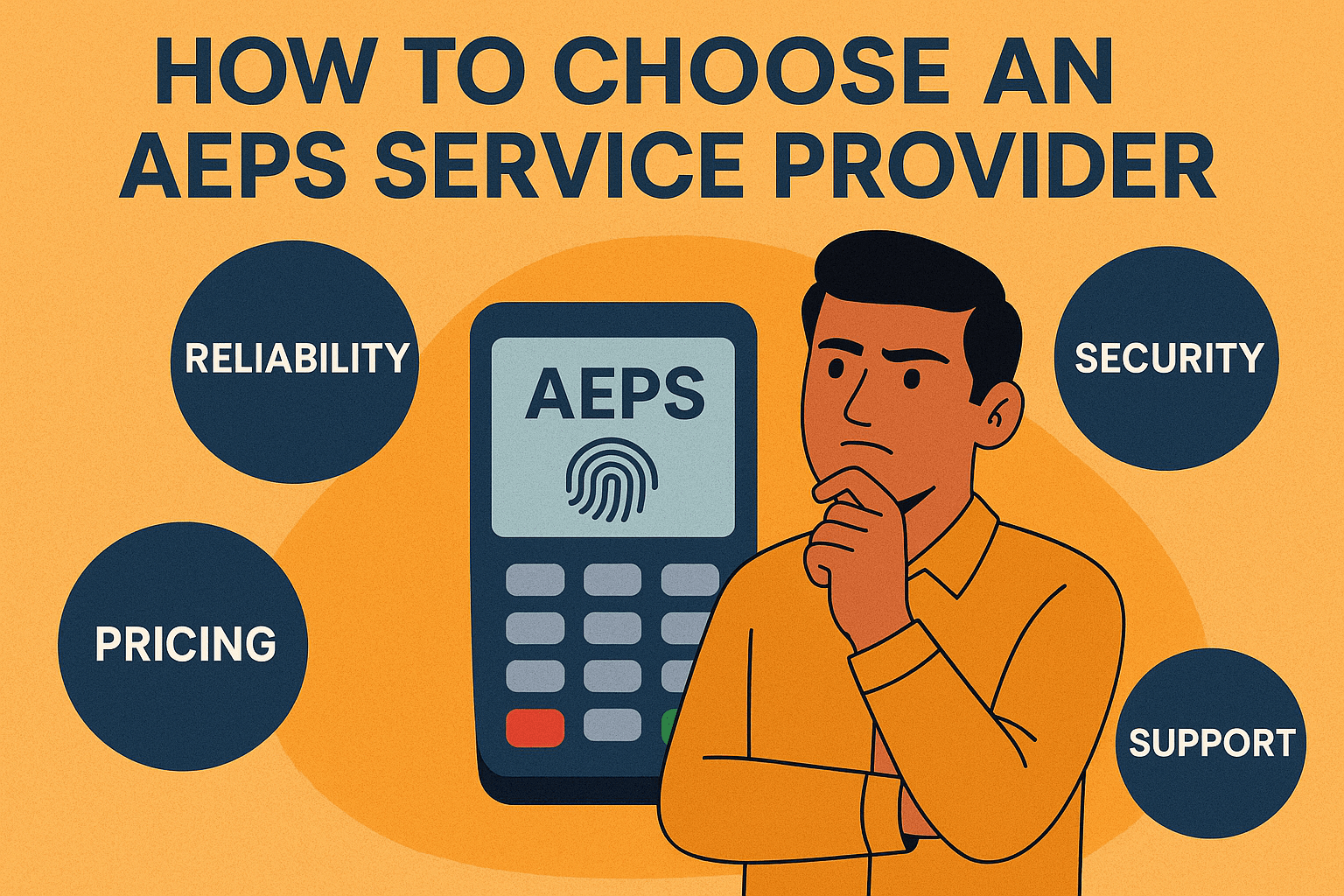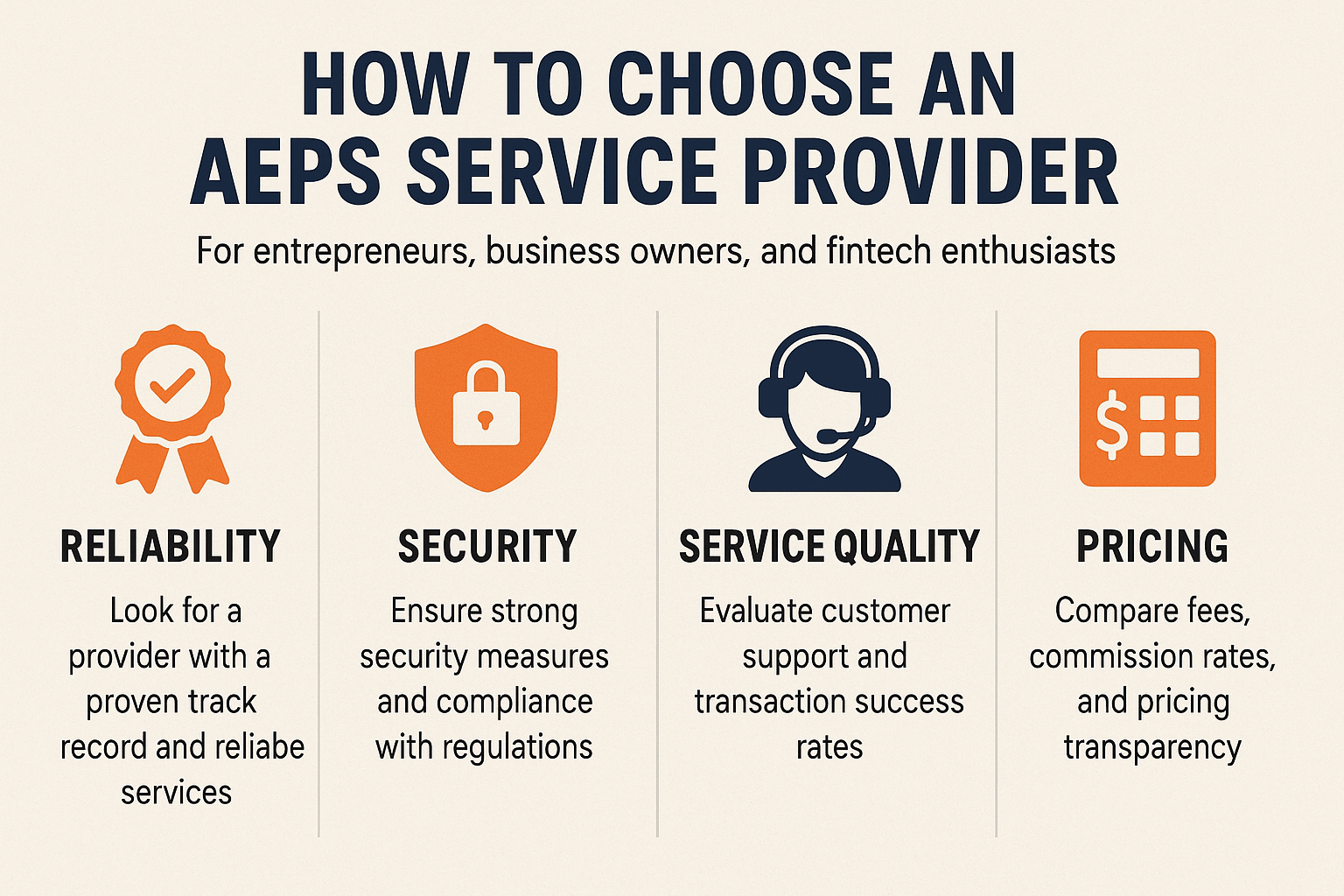In the rapidly digitizing landscape of Indian finance, how to choose an AEPS service provider is a critical question for entrepreneurs, business owners, and fintech enthusiasts. The Aadhaar Enabled Payment System (AEPS) is a powerful tool that allows customers to perform basic banking transactions using just their Aadhaar number and biometric authentication. For an agent or a business, partnering with the right provider isn’t just a technical decision; it’s a strategic one that impacts your revenue, reputation, and customer trust.
This guide will walk you through the essential steps and considerations, transforming a complex decision into a clear, actionable plan.
Image Alt Text: How to choose an AEPS service provider
Understanding the AEPS Ecosystem: More Than Just a Service
Before diving into the selection criteria, it’s crucial to understand the players. An AEPS service provider acts as a bridge between you (the agent) and the National Payments Corporation of India (NPCI), which governs the AEPS network. They provide the software, API, or POS device that enables you to offer services like:
-
Cash Withdrawal
-
Cash Deposit
-
Balance Enquiry
-
Aadhaar to Aadhaar Fund Transfer
-
Mini Statement
Your choice of provider directly influences transaction success rates, settlement speed, and the overall user experience.

7 Vital Tips on How to Choose an AEPS Service Provider
1. Verify RBI Authorization and NPCI Certification (The Non-Negotiable)
This is the most critical step. The provider must be an RBI-authorized Payment System Provider (PSP) or must be a certified Business Correspondent (BC) partnering with a bank. Furthermore, they must have direct certification from the NPCI to operate on the AEPS network.
-
What to ask: “Can you provide your RBI authorization certificate and NPCI approval documents?”
-
Why it matters: Working with an unauthorized entity is illegal and puts your business and your customers’ money at extreme risk. It’s the foundation of all trust and security.
2. Scrutinize the Technology and Platform Stability
A provider’s tech platform is the engine of your operations. It needs to be robust, reliable, and user-friendly.
-
Uptime & Reliability: Inquire about their system’s uptime (aim for 99.5%+). Frequent downtimes mean lost transactions and lost customers.
-
Device & OS Compatibility: Does their solution work on Android, iOS, and Windows? Do they offer a variety of options like a mobile app, Windows software, or dedicated biometric POS devices?
-
User Interface (UI): Test the agent app yourself. Is it intuitive and easy to navigate, especially for users who may not be tech-savvy? A clunky app slows down operations and increases the chance of errors.
3. Analyze the Pricing Structure and Transparency
Cost is a major factor in your profitability. Providers have different models, and hidden fees can quickly erode your margins.
-
Setup Fee: Is there a one-time setup or onboarding fee?
-
Transaction Charges (MDR): This is the fee deducted per transaction. Compare the MDR for different services (e.g., withdrawal vs. deposit). Is it a flat fee or a percentage?
-
Hidden Costs: Be wary of hidden charges like annual maintenance fees (AMC), minimum balance requirements, or steep charges for customer support. Demand a complete, written breakdown of all potential costs.
4. Evaluate the Settlement Cycle and Process
This is about how and when you get paid. The settlement is the process where the money from customer transactions is transferred to your bank account.
-
Settlement Time: Providers offer T+0 (same-day settlement), T+1 (next-day settlement), or even longer cycles. Faster settlement (T+0 or T+1) improves your cash flow.
-
Process Clarity: Is the process automated? Do you get clear reports and alerts for each settlement? Transparency here is key to managing your finances.
-
Settlement Failure Handling: Understand their policy for failed settlements. How quickly are issues resolved?
5. Prioritize Security and Data Privacy
You are handling customers’ most sensitive data: their Aadhaar number and biometrics. Security cannot be an afterthought.
-
Data Encryption: Ensure all data is encrypted end-to-end (E2E).
-
Aadhaar Data Handling: The provider should have a clear policy that they do not store Aadhaar numbers or biometric data. This data should only be used for authentication with the UIDAI servers and then discarded.
-
Compliance: They must be fully compliant with the Aadhaar Act and RBI’s data localization and privacy guidelines.
6. Test the Quality of Customer Support
When a transaction fails or a device malfunctions, you need help immediately. Your business can’t afford to wait.
-
Support Channels: Do they offer 24/7 support via phone, email, live chat, and WhatsApp?
-
Responsiveness: Before signing up, try reaching out to their support with a pre-sales question. Note how long it takes them to respond and how helpful they are. This is a good indicator of post-sales service.
-
Regional Language Support: If you operate in a region where Hindi or English isn’t the primary language, check if they offer support in local languages.
7. Check for Additional Value-Added Services
While AEPS is the core, many providers bundle other services that can help you increase revenue per customer.
-
Multi-Banking Services: Do they offer UPI, bill payments, recharge services, insurance, or mutual funds?
-
Business Tools: Look for features like detailed analytics dashboards, automated GST reports, and customer management tools. These can save you immense time and help you grow your business strategically.

Making Your Final Decision
Once you’ve shortlisted providers based on the criteria above, take these final steps:
-
Read Reviews and Get References: Look for independent reviews on platforms like Google Play Store, app review sites, and fintech forums. Ask the provider for references from existing agents in a similar business.
-
Start with a Trial: Many reputable providers offer a demo or a trial period. Use this to test the platform’s speed, reliability, and ease of use in a real-world scenario.
-
Read the Contract Carefully: Before you sign, read the terms and conditions thoroughly. Pay special attention to clauses about termination, fee changes, and liability.
Conclusion
Knowing how to choose an AEPS service provider is about looking beyond the superficial and evaluating the partnership on its merits of security, reliability, profitability, and support. It’s not just about who offers the lowest MDR; it’s about who offers the most stable, secure, and scalable platform for your long-term growth. By meticulously following these tips, you can select a partner that empowers your business, builds customer trust, and becomes a cornerstone of your success in the world of digital finance.
Frequently Asked Questions (FAQs)
Q1: Can I become an AEPS agent without a provider?
No, you cannot. Individual agents must operate through an RBI-authorized AEPS service provider or a bank that acts as a Business Correspondent (BC). These entities are the only ones with direct access to the NPCI network.
Q2: What is the typical MDR for an AEPS transaction?
MDR (Merchant Discount Rate) varies between providers but typically ranges from 0.3% to 0.8% for cash withdrawal transactions, often with a minimum fee (e.g., ₹5 to ₹10). It’s crucial to get the exact breakdown from your prospective provider.
Q3: What is the minimum investment required to start an AEPS business?
The investment is relatively low. The primary costs are the biometric scanner (₹2,000 – ₹6,000) and a smartphone if you don’t have one. Some providers may charge a small setup fee. There’s usually no need for a large upfront investment.
Q4: What happens if a transaction fails but the customer’s money is debited?
This is called a disputed transaction. A reliable provider will have a clear and efficient dispute resolution process. The amount is typically reversed into the customer’s account within 3-7 working days. Your role is to immediately report the issue to the provider’s support with the transaction details.
Disclaimer: This article is for educational and informational purposes only. It does not constitute financial, legal, or professional advice. The AEPS landscape and RBI regulations are subject to change. Readers are strongly advised to conduct their own due diligence and consult with a qualified professional before engaging with any service provider. If you have any concerns regarding the content of this post, please visit our DMCA page for guidance on content removal procedures.
